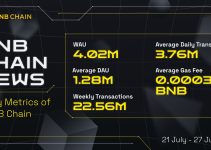What is NuCypher?
NuCypher is a Blockchain Service project that aims to re-encrypt Proxy for distributed systems. NuCypher is also a decentralized key management system (KMS: Key Management System), encryption, and access control. It allows users to share private data without fear of being eavesdropped on by other encrypted browsers.
The project encourages everyone to join a key management system to protect users’ data and information.
What problem does NuCypher solve?
The problem that NuCypher poses
Currently, between customers, businesses, or countries, they often have to communicate with each other about jobs, contracts as well as sensitive and top-secret data. The current communication process has two popular forms: “symmetrical” and “asymmetrical”.
• Symmetry is understood as using a fixed key, this key is used to encrypt and decrypt data when exchanged.
• Asymmetric is understood as using 2 different types of keys, including Public Key and Private Key to increase data security.
The current common communication process that web client services or proxies are using is a combination of symmetric keys and asymmetric keys.
• The use of asymmetric keys makes the transmission process faster. However, the disadvantage of this method is that when you transmit data too many times, hackers will be able to eavesdrop on the composition of the symmetric key and decrypt it.
• Using asymmetric keys is many times more secure, but the encryption speed is slower, the transmission takes longer.
Using the above two methods leads to:
• A lot of malicious information endangers the computers of customers, businesses, and the country.
• Data in the computers of customers as well as businesses are vulnerable to hackers infiltrating and stealing.
• The sharing of sensitive data between customers, businesses as well as countries is vulnerable to hackers.
NuCypher’s Solution
To solve the problems I just mentioned above, the dev team has applied Blockchain technology to deploy Umbral to encrypt the proxies.
Here are the features of the above method:
• Filter malicious information affecting customers’ computers.
• Secure the data of customers, businesses as well as countries from hackers.
• Prevent hackers from entering information sharing of customers, businesses, and organizations.
• NuCypher allows businesses to use secure cloud services to store data.
NuCypher’s Highlights
The project is inspired by Proxy re-encoding for today’s distributed systems. At the time of the project’s launch, this was a fairly new idea in decentralized Blockchain technology. Therefore, the technology will be somewhat different from other Blockchain projects.
In this section, I will talk more about NuCypher’s technology and how it works to make the communication process faster and safer.
Please follow the “demo” of the project below:
• Yasuo wants to send sensitive data and still be able to delegate access to someone.
• Yasuo will encrypt his data with her own Public Key, and this Public Key is stored in the cloud or some other decentralized form.
• Yasuo wants to authorize Malphite. This data will be rekeyed to Malphite’s key used to encrypt the proxy.
• Malphite will download this data and decrypt it with his key.
To implement the “demo” above, the dev team used a program called Umbral. Umbral is a proxy re-encryption program that powers the NuCypher network.
Yasuo (the data owner) can delegate decryption to Malphite through encryption performed by a trusted proxy. When these proxies join by performing re-encryption, Malphite can decrypt the data with his private key.

Here are the steps after applying the Umbral program to the proxy encryption:
Step 1: Yasuo – the owner of the data, encrypts the data with his Public Key and uploads it to IPFS, Swarm, S3, or any storage layer. To properly authorize Malphite, he generates and loads the encryption keys in two parts. One part is sent to the receiver of the data, another part is sent to the NuCypher network.
Step 2: At this point, Ursula (acting as a node) – a miner, receives the encryption keys and is ready to re-lock the data and receive a reward or payment in transaction fees. Ursula and the storage layer never have access to Yasuo’s original data.
Step 3: Malphite – the receiver of the data, sends a request to access the NuCypher network. If Malphite’s encryption keys received from Yasuo are valid with the encryption keys on the NuCypher network, the data is sent to and locked into his Public Key. And he can decrypt the data with his Private Key.

In the NuCypher ecosystem, miners act as Validator Nodes that validate transactions and transmit messages from customers, organizations, and countries.
NuCypher Token Information (NU)
Key Metrics NU
Token Name: NuCypher.
Ticker: NU.
Blockchain: Ethereum.
Token Standard: ERC-20.
Contract: 0x4fe83213d56308330ec302a8bd641f1d0113a4cc
Token type: Utility Token.
Total Supply: 3.885.390.081.
Circulating Supply: 645.437.060 – 695.250.000
NU Token Sale
• Pre Sale took place in August 2017 and raised $4.3 million.
• Price Pre Sale: 1 NU= $0.0143
• The project has no Public Sale. Main Sale took place after Mainnet.
NU Token Release Schedule:
nu-release-schedule.xlsx (nucypher.com)
Below will be the monthly token payment plan based on the inflation model that the dev team has updated on the website through token staking.

NU Token Use Case
In the NuCypher network, NU Tokens are used for the following purposes:
• Used to pay transaction costs for Nodes when there is a transmission of data between two parties on the NuCypher network.
• Used to pay for services (including Decentralized Dropbox and Encrypted Slack) in the NuCypher network.
• Staking in Nodes and getting rewards in return is NMS Token.
NU is a token built on Ethereum’s ERC-20 platform. So when transacting or transferring NKMS, users will have to bear the following fees:
• Blockchain network transaction fees collected by Ethereum.
• Transaction fees on the floor: withdrawal fees, transaction fees collected by the exchange.
How to earn and own NU Token
You can earn NU by participating in the project’s Airdrop and Bounty programs to receive free Tokens.
In addition, you can receive NU Tokens by participating in becoming Validator Nodes to staking NU coins and receive NU rewards in return.
NU Token exchange & storage wallet
NU Token storage wallet
The NU token is developed on the Ethereum ERC-20 platform. So you can store NuCypher (Nu) on Ethereum wallets like:
• Web Wallet: Myetherwallet, Mycrypto, Metamask,…
• Hardware Wallet: Ledger Nano S, Trezor.
• Mobile Wallet: Atomic Wallet, Trust Wallet, ImToken,…
Roadmaps & Updates:
NuCypher (NU) Roadmap | Messari
Project team, investors, partners
Project team

Partners and investors

Comments about NU Token:
In NuCypher’s Business Model, you can imagine the following:
NKMS is built on top of ERC-20. On top of that, dApp developers can secure their data and that of their customers.
At the same time, to operate this platform, Validator Nodes are required to confirm and must have NKMS Token for them to stake and reward them.
According to an IDC report, annual spending on public cloud IT services will reach $158 billion by the end of 2020.
With continuous innovation and data communication challenges that large enterprises are facing when using cloud technology and big data. NuCypher will have an advantage in competing with current data storage and transmission platforms such as OneDrive, Google…
That means that in the future when the number of users of NuCypher increases, the number of dApps as well as the number of transactions on these decentralized applications will also increase.
That means transaction fees will also increase, Validator Nodes will also increase. At that time, the need for NKMS Token to stake also increased. That has a strong impact on the price of NKMS.


